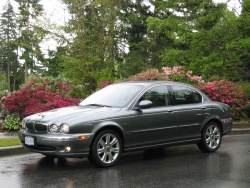 2003 Jaguar X-Type. Click image to enlarge |
|
Manufacturer’s web site |
By Chris Chase
The X-Type was Jaguar’s attempt to increase sales by competing in the popular entry-level luxury sedan segment. The little Jag had its work cut out for it considering it would have to compete against established German cars like the BMW 3 Series, Audi A4 and Mercedes-Benz C-Class, and successful Japanese entries like the Acura TSX/TL, Lexus IS and Infiniti G35.
In one way, the car was a victory, as it became Jaguar’s best-selling model worldwide, however it didn’t meet Jaguar’s an annual global sales target of 100,000 cars. The X-Type was launched here in 2002, and was discontinued in late 2007, but not before a number of cars were allocated to be sold as 2008 models.
The X-Type is based heavily on the Ford Mondeo, a mid-sized car sold in Europe. While this certainly allowed Ford (which owned Jaguar) to keep the X-Type’s development costs down, some observers felt that the X-Type was little more than a dressed-up version of the Mondeo. Read the first post in this thread for one such opinion.
Those who bought X-Types new got a choice of either a 2.5-litre (192 hp) or 3.0-litre (227 hp) V6 engines. The resources I rely on for technical information have let me down this time, contradicting each other with regards to the X-Type’s transmission options.
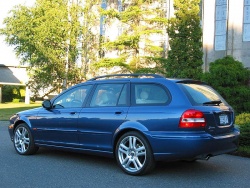 2004 Jaguar X-Type. Click image to enlarge |
For certain, 2.5-litre cars could be had with either a five-speed manual or an optional five-speed automatic. The 3.0-litre engine was available with either transmission as well, at least in certain model years. One thing is for certain: the X-Type boasted standard all-wheel drive.
In 2004, Jaguar added an attractive station wagon to the X-Type line. The 2006 model year saw the 2.5-litre engine and trim line deleted, though the manual transmission remained as standard equipment. That, too, would disappear in 2007. The 2008 X-Type got a mild restyling, just in time for it to be discontinued in North America.
Fuel consumption seems high but that can likely be attributed to the all-wheel drive system. The X-Type’s EnerGuide numbers range from about 12 to 13 L/100 km (city) and 7.8 to 8.5 L/100 km (highway), with 2.5-litre engine models earning the lower consumption figures.
Word has it that the alloy wheels used on the X-Type are very susceptible to damage caused by potholes, so watch where you drive.
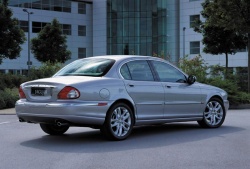 2004 Jaguar X-Type. Click image to enlarge |
The X-Type was sold exclusively with all-wheel drive, which means that all X-Types are possible candidates for a common problem with the transfer case – the set of gears that transfers power to the rear axle. Early signs of trouble are a whining noise from the transfer case, gear oil leaking from the case’s vent hose, and a clunking noise that occurs while decelerating to a stop.
The best preventative measure is to change the transfer case oil regularly (though Jaguar states the transfer case is a sealed-for-life unit). Normally, this is a “hellish” job that requires removal of exhaust components, but a poster at Jag-Lovers.org has devised an easier way. You may have to register at the site to view the post.
It has been suggested that the X-Type uses brake calipers that are prone to seizing, which can subsequently cause further brake problems, as well as negatively affect fuel consumption.
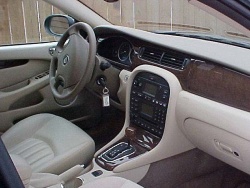 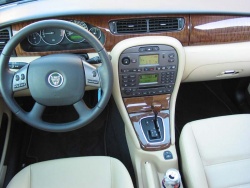 2003 Jaguar X-Type (top); 2004 Jaguar X-Type. Click image to enlarge |
Watch for a centre rear seat belt that can get stuck in the fully-retracted position. The belt mechanism is inside the folding rear seatback; the easy fix is to fold the seat down, whack the seatback, then give the seat a good slam back into position. If this doesn’t work, the seat will need to be opened up and the mechanism serviced or replaced.
Consumer Reports only offers reliability information for X-Types built from 2002 through 2004, but what information they do have suggests that this car suffers from worse-than-average dependability.
The X-Type crash tests results are encouraging, however. The car earned four stars all around in the National Highway Traffic Safety Administration’s (NHTSA) frontal and side impact tests. In the Insurance Institute for Highway Safety’s (IIHS) frontal offset crash test, the X-Type earned a “good” rating, though the organization’s side impact test resulted in a “marginal” rating, thanks to poor protection for the driver’s torso and a poor performance by the car’s passenger compartment structure in the test.
If you’re jonesing for a used X-Type but are worried you won’t be able to afford one, you’ll be pleased to learn that the car suffers from poor resale value common to all Jaguar models. According to Canadian Black Book, X-Types are worth between $7,200 for a 2002 2.5 model, to $25,500 for a 2008 3.0-litre wagon with navigation. I’m partial to the wagon myself, and I think the $15,675 Red Book value for a 2006 model sounds like a good deal – as long as you can put up with this car’s finicky reliability. You might be better off spending a few more bucks for an A4 or 3 Series, though they can’t boast stellar records for dependability, either. One thing is for sure: the X-Type’s slow sales when new ensure a certain level of exclusivity for those who do own them.
|
Pricing
Black Book Pricing (avg. retail) January, 2012:
Online resources
Recalls
2002-2003: On certain vehicles, when power is lost to the external turn signal indicators, the internal “tell tales” flash as if there was no fault which is in contravention or the vehicle compliance requirements. The General Electric Module (GEM) design includes feedback to the driver via a “tell tale” function for bulb failure but does not include feedback in the event of power loss to the Direction Indicator System. Correction: Dealer will replace the General Electric Module (GEM). Transport Canada Recall Number: 2004337; Units affected: 124 Transport Canada Recall Number: 2004339; Units affected: 353
Crash test results
Used vehicle prices vary depending on factors such as general condition, odometer reading, usage history and options fitted. Always have a used vehicle checked by an experienced auto technician before you buy. For information on recalls, see Transport Canada’s web-site, www.tc.gc.ca, or the U.S. National Highway Transportation Administration (NHTSA)web-site, www.nhtsa.dot.gov. For information on vehicle service bulletins issued by the manufacturer, visit www.nhtsa.dot.gov. For information on consumer complaints about specific models, see www.lemonaidcars.com. |











